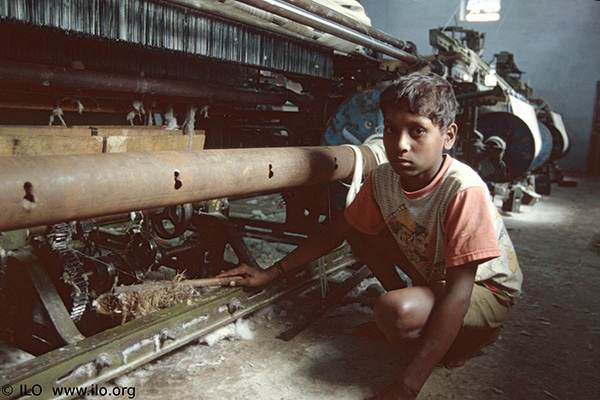“How much do you know about your favorite cotton T-shirt’s journey to your closet?”
This question opened the Department of Labor’s annual “Findings on the Worst Forms of Child Labor” report released last week, emphasizing the importance of monitoring supply chains to ensure that consumers do not unknowingly support worker exploitation and child labor through their daily purchases.
 “Abusive labor practices, such as forced labor and child labor, harm millions of children, women and men by enabling goods to be produced at artificially low prices,” U.S. Secretary of Labor R. Alexander Acosta said. (Picture ILO / FaiQe Sumer)“Unfortunately, there are sometimes hidden, non-monetary costs associated with the goods Americans purchase. Abusive labor practices, such as forced labor and child labor, harm millions of children, women and men by enabling goods to be produced at artificially low prices,” observed U.S. Secretary of Labor R. Alexander Acosta in the report’s forward. “We all run the risk of indirectly and unwittingly contributing to the perpetuation of shadow industries where goods are made on the backs of children and modern-day slaves.”
“Abusive labor practices, such as forced labor and child labor, harm millions of children, women and men by enabling goods to be produced at artificially low prices,” U.S. Secretary of Labor R. Alexander Acosta said. (Picture ILO / FaiQe Sumer)“Unfortunately, there are sometimes hidden, non-monetary costs associated with the goods Americans purchase. Abusive labor practices, such as forced labor and child labor, harm millions of children, women and men by enabling goods to be produced at artificially low prices,” observed U.S. Secretary of Labor R. Alexander Acosta in the report’s forward. “We all run the risk of indirectly and unwittingly contributing to the perpetuation of shadow industries where goods are made on the backs of children and modern-day slaves.”
There were 218 million working children (ages 5-17) in 2016 – 152 million are involved in child labor and 73 million in hazardous labor (a specific category within child labor).
“Working children (children in employment) are those engaged in any economic activity for at least 1 hour during the reference period,” the report explained. “Child labor includes employment below the minimum age as established in national legislation (excluding permissible light work), the worst forms of child labor and hazardous unpaid household services.”
Hazardous labor, as defined by the International Labor Organization (ILO), refers to “work which, by its nature or the circumstances in which it is carried out, is likely to harm the health, safety or morals of children.”
The report analyzed the progress of 135 nations in reducing child labor, finding that 23 countries (17 percent) have seen significant advancement, 59 (44 percent) moderate advancement, 43 (32 percent) minimal advancement, and 8 (6 percent) no advancement.
No assessment was available for Burma (Myanmar) or Wallis and Futuna (located in the South Pacific).
“All five regions had at least two countries receive an assessment of Significant Advancement, with Latin America and the Caribbean with 10 countries, followed by Sub-Saharan Africa with six countries, the Middle East and North Africa with three countries; Asia and the Pacific with two countries; and Europe and Eurasia with two countries,” the report said.
While praising the significant progress since 2000, the report expressed concern that “the pace of progress has slowed in recent years” and that “the proportion of children in child labor in Sub-Saharan Africa continues to increase.”
Enacting laws prohibiting child labor is a vital part of the process, but they must be effectively implemented to bring about positive change. “Laws – even the most perfectly crafted statutes – are meaningless if they are not enforced,” the report emphasized.
In 2016, 106 of the 135 countries analyzed in the report have a means for workers to voice complaints about working condition, 86 conducted routine labor inspections, 79 had unannounced inspections, 64 allowed inspectors to assess penalties for violations, and 39 have enough inspectors to meet ILO standards.
Countering these positive indicators is the fact that “55 of the 135 governments included in this report made no meaningful efforts to enforce laws related to child labor, including 30 governments that made no known law enforcement efforts whatsoever related to child labor.”
The full report is available here.
This article originally appeared on EthicsDaily.com.
